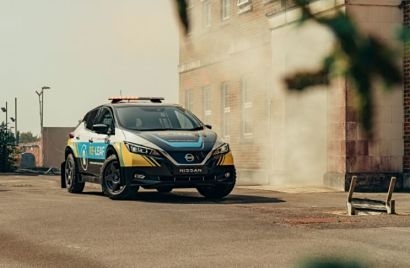
Called RE-LEAF, the working prototype is based on the Nissan LEAF passenger car, the world’s first mass-production electric vehicle. Alongside modifications to navigate roads covered in debris, the RE-LEAF features weatherproof plug sockets mounted directly to the exterior of the vehicle, which enable 110 to 230-volt devices to be powered from the car’s high-capacity lithium-ion battery.
The RE-LEAF can be driven into the centre of a disaster zone and provide a fully mobile power supply to aid the recovery process. The integrated energy management system can run medical, communications, lighting and other life-supporting equipment.
Natural disasters are the biggest cause of power outages. A 2019 World Bank report found natural shocks and climate change caused 37 percent of outages in Europe between 2000 and 2017, and 44 percent of outages in the US over the same period.
When a disaster hits, the time for electricity supply to be restored is typically 24-48 hours, depending on the severity of the damage. During that period, electric vehicles can provide zero-emission, mobile emergency power.
Nissan created the RE-LEAF to demonstrate the potential of electric vehicles in disaster recovery. Although it’s just a working concept, the technology is already being used in the real world. In Japan, Nissan has used the LEAF to provide emergency power and transportation following natural disasters since 2011, and the company has formed partnerships with more than 60 local governments to support disaster relief efforts.
Nissan EVs can also act as mobile storage batteries to supply homes and society with electricity during non-emergency situations through Nissan Energy Share, creating a distributable energy model that can be used to help stabilize supply and demand.
The RE-LEAF uses the LEAF’s bi-directional charging ability, a standard feature of the model since its introduction in 2010. This means the LEAF can not only ‘pull’ power to recharge the high-capacity battery, but also ‘push’ it back to the grid through V2G (Vehicle-to-Grid) technology, or directly to electronic devices through V2X (Vehicle-to-everything).
Acting as a portable power station, the latest generation Nissan LEAF e+ with a fully charged 62 kilowatt-hour (kWh) battery can provide enough electricity to power the average UK household for around six days.
As a disaster recovery vehicle, the RE-LEAF can power multiple devices. Some example 230v power consumptions are detailed below:
Electric Jack Hammer – 24 hours – 36kWh
Pressure Ventilation Fan – 24 hours – 21.6kWh
Intensive Care Medical Ventilator – 24 hours – 3kWh
100 watt LED flood light – 24 hours – 2.4kWh
Once electricity is restored to the area, EVs can be recharged and provide zero-emission transport – up to 239 miles (WLTP Combined) on a single charge of a LEAF e+ battery.
“Through Nissan Intelligent Mobility, we’re constantly exploring ways that electric vehicles can enrich our lives, beyond just zero-emission transportation” said Helen Perry, Head of Electric Passenger Cars & Infrastructure for Nissan in Europe. “Concepts like the RE-LEAF show the possible application of EVs in disaster management and demonstrate that smarter, cleaner technology can help save lives and provide greater resilience for the future. Electric vehicles are emerging as one of the technologies that can improve resilience in the power sector. By having thousands of EVs available on standby, either as disaster-support vehicles or plugged into the network through Vehicle-to-Grid (V2G), they’re uniquely capable of creating a virtual power plant to maintain a supply of energy during a major outage.”
Dan Cooke, Operations Director at Serve On, the UK's leading organisation providing emergency search and rescue in natural disasters around the world, added that when responding to a disaster, two critical factors that make all the difference are establishing communications, and staying hydrated and that situational awareness saves lives and running a ‘command and control’ centre allows us to get the real picture of what’s happening whilst the infrastructure gets back online, but that needs power.
“Seeing the RE-LEAF is really exciting, because we love exploring new ideas to see what’s possible” Mr Cooke said. “Looking back to previous scenarios we’ve dealt with, this technology could have made a real difference. For example being able to power multiple filtration devices to produce thousands of litres of drinking water – essential in our line of work.”
The RE-LEAF supports the three ‘REs’ of disaster preparedness – providing an emergency response, aiding the humanitarian recovery and improving community resilience for the future. The RE-LEAF’s amber colour scheme is a nod to the ancient Greek word for amber – electron – the origin of the word ‘electricity’. This pairs with the blue colour scheme of Nissan’s Intelligent Mobility vision to reference the concept’s connected abilities. A roof-mounted LED light bar also displays amber flashes to alert other road users to the vehicle’s approach.
To help the car navigate roads with obstructions or fallen debris, the RE-LEAF’s ride height has been raised by 70mm to 225mm with a custom ‘sump guard’ to protect the car’s floor pan. Wider tracks (+90mm front / +130mm rear), custom wheel arches, mud flaps and all-terrain tyres on 17-inch motorsport wheels add to the capability.
The large capacity and high reliability of the LEAF’s lithium-ion battery ensures a stable power supply to support multiple mains-powered devices. The integrated energy management system is able to output the RE-LEAF battery’s power at up to 230v. There are three sockets – two weatherproof external C-Form connectors for easy access, and an internal domestic socket mounted in the boot.
The rear seats have been removed and the floor levelled to provide storage for essential equipment. A custom bulk-head cage also separates the front seats from the cargo area.
Once the RE-LEAF arrives at a disaster zone, a bespoke pull-out desk extends from the boot with a 32-inch LED screen and dedicated power supply creating an operational hub to run communications from and manage the recovery process.
Once power is restored, the LEAF can be recharged using three charging profiles, even using domestic sockets if no EV infrastructure is available in the immediate vicinity.
For additional information:

